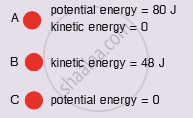Advertisements
Advertisements
प्रश्न
A boy weighing 40 kg makes a high jump of 1.5 m.
What is his potential energy at the highest point? (g = 10 m/s2)
उत्तर
Mass of the boy, (m) = 40 kg
Acceleration due to gravity, (g) = 10 m/s2
Height above the ground, (h) = 1.5 m
We can calculate potential energy as,
P.E = (m) (g) (h)
So,
P.E = (40)(10)(1.5) J
= 600 J
APPEARS IN
संबंधित प्रश्न
A body falls freely under gravity from rest. Name the kind of energy it will possess while falling.
A ball of mass 0.20 kg is thrown vertically upwards with an initial velocity of 20 m s-1. Calculate the maximum potential energy it gains as it goes up.
Fill in the blank with suitable word :
The sum of the potential and kinetic energies of a body is called __________ energy.
What are the various forms of energy?
An iron sphere of mass 10 kg has the same diameter as an aluminium sphere of mass 3.5 kg. Both the spheres are dropped simultaneously from a tower. When they are 10 m above the ground, they have the same :
Name the device which converts electrical energy into mechanical energy.
Name the device or machine which convert :
Light energy into electrical energy.
Fill in the blanks with suitable words :
The principle of ___________ of energy says energy can be transformed from one form to another, but it cannot be ___________ or ___________.
A ball falls to the ground as shown below :
What is the kinetic energy of ball when it hits the ground?
An automobile engine propels a 1000 kg car (A) along a levelled road at a speed of 36 km h–1. Find the power if the opposing frictional force is 100 N. Now, suppose after travelling a distance of 200 m, this car collides with another stationary car (B) of the same mass and comes to rest. Let its engine also stop at the same time. Now the car (B) starts moving on the same level road without getting its engine started. Find the speed of the car (B) just after the collision.
